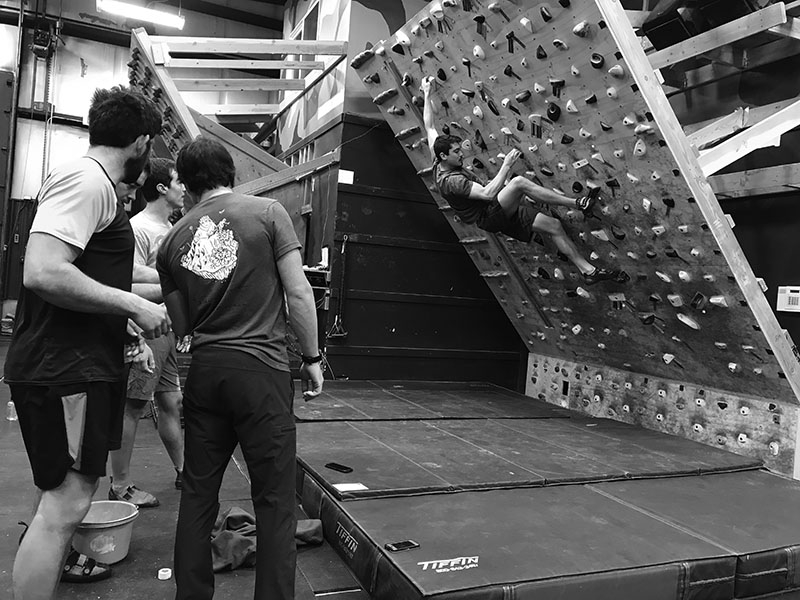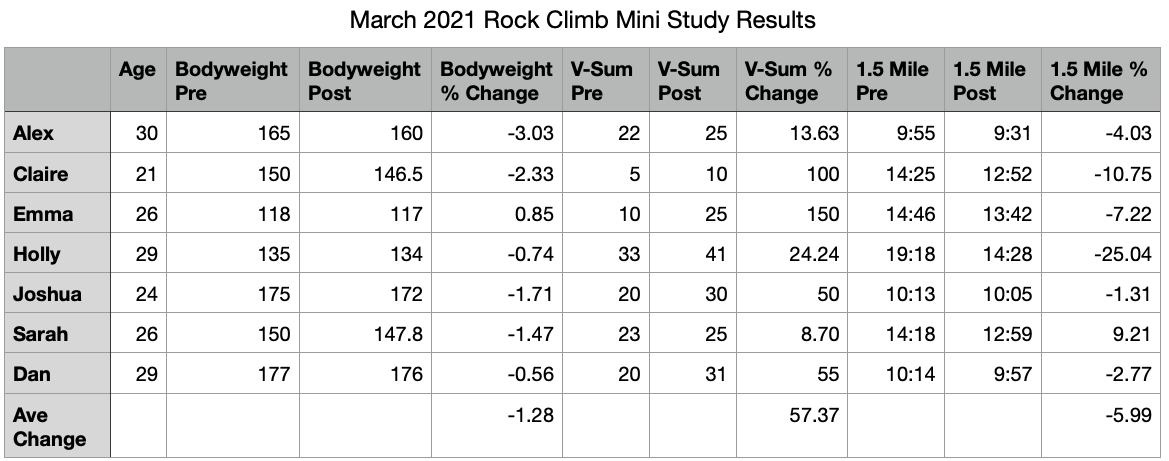By Rob Shaul, Founder
BLUF
Remote lab rats following 4.5 weeks of MTI’s 6 day/week, Pre-Season Rock Climbing Program and nutritional guidelines increased an assessed bouldering performance an average of 57.35% and decreased bodyweight an average of 1.28%.
Background and Study Design
This mini-study tested the effectiveness of MTI’s current/published Rock Climbing Pre-Season programming to improve bouldering performance, and MTI’s nutritional guidelines, combined with the climb programming, to decrease bodyweight.
Seven remote lab rats with access to a bouldering gym and/or Moon Board, and a campus board, completed the study, three men and four women. In addition to following the programming, the lab rats were required to follow MTI’s nutritional guidelines in an effort to cut body fat, which can have a dramatic effect on finger/grip relative strength and climbing performance.
MTI’s Rock Climbing Pre-Season Training Plan is built around the Bouldering V-Sum – a unique, timed, assessed event completed in a bouldering gym and/or on a Moon Board. Over the years we’ve found the Bouldering V-Sum a powerful tool to improve climbing fitness, climbing mental fitness, and technical climbing ability, concurrently.
The training cycle began with a V-Sum assessment, and the lab rats completed a 50-minute and a 40-minute Bouldering V-Sum weekly. The plan also included short, intense single-mode work capacity (sandbag getups and shuttle sprints), interval climbing strength work, a 1.5 mile run assessment and follow on 800m intervals, and a moderate weekend run.
Week 1 of the plan included a Bouldering V-Sum, work capacity and 1.5 mile run assessment. The lab rats re-completed these assessments at the end of the study and the results were compared.
Below was the weekly schedule:
- Monday: 50-minute, 8-Problem Bouldering V-Sum
- Tuesday: Climbing Power, Sandbag Getups
- Wednesday: 1.5 Mile Run Assessment or 800m Intervals
- Thursday: 40-minute, 4-Problem Bouldering V-Sum, Work Capacity
- Friday: Foot-on Campus Board Intervals, Work Capacity Intervals (shuttle sprint repeats)
- Saturday: 5-7 Mile Moderate Pace Run
Athletes were allowed to complete other training during this mini-study – just no additional Dead Hang or Front Plank work.
The initial and last Max Effort for Time Dead Hang and Front Plank results were compared.
What we hoped to learn:
- Is the program progression and intensity doable for remote athletes? We’ve coach climbers through this intense program at our Wyoming facility but have never tracked athletes completing it remotely.
- The effect of work capacity and endurance programming plus dietary restrictions on weight loss and the impact of weight loss on climbing improvement. With our in-person athletes, we’ve never required them to follow our nutritional guidelines.
- Assessed improvement in climbing proficiency from the programming. As measured through improvement on the Bouldering V-Sum.
Results and Discussion
A total of 7 individuals completed the entire training 4.5 week cycle. Below are the individual lab rat results.
The lab rats increased an assessed bouldering performance an average of 57.35%, and decreased bodyweight an average of 1.28%. As well, they achieved an 5.99% speed improvement on the 1.5 Mile run assessment.
This year’s remote lab rats outperformed our 2019 in-gym lab rats for V-Sum improvement. The cycles between the two groups were very similar, however the 2019 in-gym lab rats completed a full 6-week training cycle, and achieved an average improvement Bouldering V-Sum improvement of 37.5%.
However, this difference in improvement is likely attributed where both groups began. In general, experienced, better climbers will achieve less improvement over the course of the cycle, less experienced climbers will see more improvement.
The 2019 in-gym Lab Rats began with an average Bouldering V-Sum of 31, as compared to the average initial V-sum for this year’s remote lab rats of 19. On average, the 2019 in-gym lab rats were better climbers and has less room for improvement.
The 2019 results are below:
We were surprised the limited weight loss for the 2021 remote lab rat group. In our experience most athletes will experienced a 5-15 pound weight loss after four weeks of following MTI’s Nutritional Guidelines and the average bodyweight loss of 1.28% is below that.
Finally, it could be fairly argued that this study “trained to the test” by deploying the Bouldering V-Sum as both the assessment tool for the study, and as a primary training tool (2x/week) in the training program.
From our perspective, all that matters is outside performance, and we’ve found great transfer between improvement in Bouldering V-Sum and outside climbing performance. So …. we don’t apologize for this but acknowledge how it affects the study.
Next Steps?
The one disappointing result of the study result was the limited weight loss the lab rats experienced following MTI’s Nutritional Guidelines. Next week we start another study with remote lab rats testing the performance impacts of these guidelines, as well as testing weight loss.
Questions? Email rob@mtntactical.com
Comments? Please comment below.
You Might Also Like MTI’s 357 Strength Training Plan
STAY UPDATED
Sign-up for our BETA newsletter. Training tips, research updates, videos and articles - and we’ll never sell your info.



